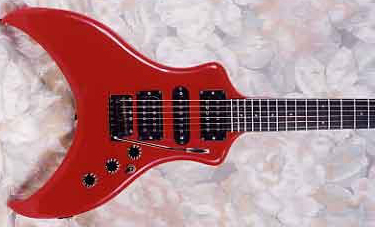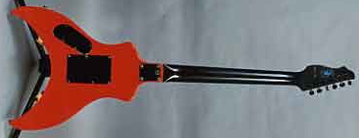I love the classic guitar shapes. They’re what attracted me to the guitar oh those many years ago. But as you can probably tell from these little essays, I’m also a sucker for a pretty face. Pretty weird, that is. Like this 1983 Electra Lady XV1RD with a Little Dutch Girl shape!

1983 Electra Lady XV1RD Electric Guitar
We’ve already talked about that great period in the early to mid-1980s when the New Wave of Heavy Metal, combined with the emergence of L.A. as an important music center, Eddie Van Halen, and hair bands. For just a couple years before Superstrats hijacked everyone, weird-shaped pointy guitars were hip. Well, this is an example of a guitar that takes that to the extreme!
Electra guitars were made by Matsumoku in Japan for St. Louis Music (SLM). SLM started in the 1920s and grew to be a large regional music distributor. They were thick with Kay and from the late 1950s or so through to Kay’s collapse in 1968 offered Kay-made Custom Kraft guitars. Some of these, especially the later ones, are really pretty good guitars. We’ll profile one in time.

1983 Electra Lady XV1RD Electric Guitar
Like everyone else, SLM couldn’t resist the allure of Japan. Sometime in the late-’60s, SLM started to bring in guitars with the Electra brand. It was probably pretty tentative at first. But when Valco/Kay went under, options were running out. In around 1970 they introduced a “copy” of the Ampeg Dan Armstrong “See-Through” guitar called The Electra. This coincided with the rise of the copy era, and it wasn’t long before Electra was competing with Ibanez for the “beginner” market and beyond. One advantage they had was that they hired a guitar designer named Tom Presley who started designing guitars and supervising the manufacture of the electronics in St. Louis. From a certain point on, guitars came made by Matsumoku but without pickups, which were installed in the US. Those open-coil zebra pickups on Japanese Electras were American. Paul Yandell, who backed Chet Atkins, endorsed them.
Other stuff happened, but this brings us up to the early 1980s and the craze for pointy guitars. Two things happened in around 1983. One: SLM started playing with new pointy guitar designs. Two: SLM entered into a joint venture with Matsumoku and began a year-long process of taking over Matsumoku’s own brand name Westone.

1983 Electra Lady XV1RD Electric Guitar
There were a bunch of different radical designs introduced by SLM, including this Lady (obvious name!). All had the same hardware and electronics, but different shapes. The shapes speak for themselves. The cool thing was the electronics. These had two humbuckers on either side of a reverse-wound single-coil. This was Presley’s idea from back in 1971. This was controlled by a 3-way with a master volume, two tone controls for the humbuckers, and three pull-up pots. The front pot tapped the humbuckers to single coil. The middle pot activated the middle reverse-wound single-coil, and the rear pot has an out-of-phase function. There are 11 possible pickup combinations, making this one of the most versatile tonal layouts ever invented. These are great, hot, swell-playing guitars! Comfortable too! If you like to sit down, as I do in my old age, this fits very nicely with a classical position. And relatively rare. According to Presley, fewer than 200 of these were ever made. This was not cheap either. Cost was $439.50 in 1984.
From 1983-84 SLM changed its brand from Electra to Electra-Westone to Westone. You see examples of these strange shapes under a variety of names. By 1985 this novel switching system was gone and the Superstrat form was adopted. Too bad. By 1987 or ’88 Singer Sewing Machines had bought Matsumoku and killed guitar production. SLM changed the brand to Alvarez (it’s acoustic brand) and switched production to other plants, including Korea.
It’s kind of funny in a way. Rock and roll has this image and reputation for being on the edge. You know, sex, drugs, throwing TV sets out of your hotel window. Yet if you look at it from a guitar point of view, things look way more conservative. The vast majority of guitar players like the classic old shapes. Not everyone, but most. Except every once in awhile things get turned on their heads. Like when this Electra Lady was made.

This was my first real guitar, after a noisy, buzzy p.o.s. Teisco. I put a Washburn Wonderbar on it, and a S.D. double coil in the bridge position, but I kept the nifty wiring configuration the same. I really enjoyed that guitar. I would like to find another just like it.
I happen to have one just like it. If you’re interested in it, give me a call or text at 317-721-6853
How much are you askin Wes? I have one of these that go painted black an. Needs a lot of work to get it playing but I love the look and sound of these and woul like to have one in better condition the the one I have
Scar,
Sorry for the delayed reply! My XV!RD has perfect intonation and plays beautifully. The tone is unreal. One sold in 9/10 condition on ebay 3 weeks ago for $3490 which seemed like a stretch, but given only 200 were made, I suppose it’s worth whatever someone who really wants one is willing to pay. I’ve got a grand in mine. I swapped an SRV Strat for it a few years ago, and have never looked back. I’m getting ready to undergo a medical procedure that’s going to have me down for a bit of time, so I’m selling some of my relics to make sure I can keep the family living the same while I recover. Newborn baby and all… I’d part from it for $750. Call or text me at 317-721-6853 if you’re still interested.
I have red Lady XV1 with original hard case and original receipts that is in great condition and 100% original. The frets are like new, this guitar sat in a closet for years. I would consider any reasonable offer. I doubt if you could ever find another one in this condition. I would even consider cash plus trades also.
Heya, Michael, I enjoyed finding this! I’m working on a short article about SLM, and your piece has helped flesh it out. I’d like to add a couple of notes.
Not all Electras are MIJ. In 1975, SLM established a new division, SLM Electronics, to build the Electra MPC guitar (two swappable modules, remember?). Then they went into amps, launching the Crate brand (1978). (All Crate were USA-made for many years.) The division grew so fast it needed a new plant in 1980, then again in 1986, the same year SLM acquired Ampeg.
Matsumoku made cabinets, and was partially acquired by Singer Japan in 1951. In the early ’60s, Singer moved some production elsewhere, leaving Matsumoku with excess capacity, so they chose guitars, and applied CNC, changing the industry.
“Mats” was great on woodwork, but knew almost nothing about marketing their own brands, so depended on steady contract work, which is why they went under. They once built many (most?) Epiphones for Aria. When Henry J bought Gibson from Norlin (1986), he switched Epi to cheaper plants. Soon after, Singer collapsed, and Matsumoku couldn’t afford to buy itself loose, so closed the doors.